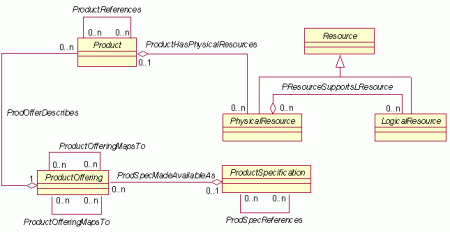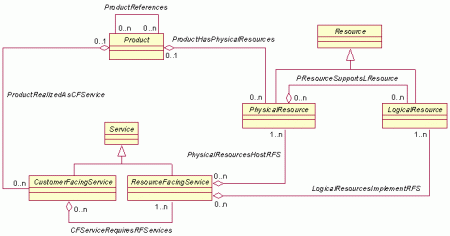About resources, services and products according to TMForum specifications
The terms resource, service and product, due to frequent use in different senses when modeling and designing, require some clarification. In particular, the relationship of these concepts, their types and relationships are the subject of potential disputes and misunderstandings. This article attempts, based on the specifications of TMForum, to assemble a model of these concepts.
The product represents what is offered to the market. Service and Resource provide varying degrees of detail on how products offered to the market are sold. Services are also presented to the market, but additional conditions are imposed on their presentation. This property of services and leads to most of the ambiguity of interpretations. To avoid this ambiguity, services can be divided into two types: "services for the customer" and "resource services." The first are involved in the formation of the Product, and the second are involved in the implementation of services for the customer. Further, this difference will be described in more detail and recorded as a model.
A resource is a generic term for representing entities that have controllability and incorporation into the Product.
The resource can be of two types - physical and logical.
')
A Physical Resource (PhysicalResource) represents one or more physical aspects or capabilities of a Resource. A Logical Resource (LogicalResource) represents one or more logical aspects or capabilities of a Resource. By dividing Resources into Physical and Logical, it allows you to represent a technically complex object with a large number of properties and capabilities (for example, a router) as a set of simpler components, each of which is convenient to model. Business entity The product represents what can be offered to the market. The resource is part of the provider's infrastructure, and is used in the Service to offer the market in the form of a Product. Entity Resource specifies the implementation of those Products that are offered to the market. Resources are used to support the Services offered in the Product.
For example, a VPN requires a physical port to connect, as well as one or as far as protocols. The port is a physical entity - you can see it, you can connect to it. On the other hand, protocols are logical entities, because they represent a set of rules and algorithms, as well as packets transmitted over a network. Together, both Physical Resources and Logical Resources are required to configure a VPN.

Figure 1. Initial Resource View Diagram
In the eTOM process map, a Resource refers to several different things, depending on the depth of detail:
The product represents what is offered to the market. Service and Resource provide varying degrees of detail on how products offered to the market are sold. Services are also presented to the market, but additional conditions are imposed on their presentation. This property of services and leads to most of the ambiguity of interpretations. To avoid this ambiguity, services can be divided into two types: "services for the customer" and "resource services." The first are involved in the formation of the Product, and the second are involved in the implementation of services for the customer. Further, this difference will be described in more detail and recorded as a model.
A resource is a generic term for representing entities that have controllability and incorporation into the Product.
The resource can be of two types - physical and logical.
')
A Physical Resource (PhysicalResource) represents one or more physical aspects or capabilities of a Resource. A Logical Resource (LogicalResource) represents one or more logical aspects or capabilities of a Resource. By dividing Resources into Physical and Logical, it allows you to represent a technically complex object with a large number of properties and capabilities (for example, a router) as a set of simpler components, each of which is convenient to model. Business entity The product represents what can be offered to the market. The resource is part of the provider's infrastructure, and is used in the Service to offer the market in the form of a Product. Entity Resource specifies the implementation of those Products that are offered to the market. Resources are used to support the Services offered in the Product.
For example, a VPN requires a physical port to connect, as well as one or as far as protocols. The port is a physical entity - you can see it, you can connect to it. On the other hand, protocols are logical entities, because they represent a set of rules and algorithms, as well as packets transmitted over a network. Together, both Physical Resources and Logical Resources are required to configure a VPN.

Figure 1. Initial Resource View Diagram
In the eTOM process map, a Resource refers to several different things, depending on the depth of detail:
- At Level 0, a Resource is defined as “processes, including those related to the development and management of infrastructure, which are related to the Products or Services, or that support the functioning of the infrastructure itself”, but the processes not mentioned are not detailed.
At Level 1, two Resource uses are defined:- Management of Resources and Operations (RM & O): these processes support knowledge of resources and are responsible for managing resources in the provision and support of services required or offered to customers. RM & O also includes functions for collecting information about resources, and subsequent integration, correlation and aggregation for transfer to service management systems, or to take action with a resource.
Development and Resource Management (RD & M): these processes focus on planning, developing and installing the resources needed to support services and products in operations. RD & M includes the functionality necessary to define a network development strategy, as well as testing new technologies and analyzing the existing capabilities of resources to support future needs.
At Level 2, both groups of processes mentioned at level 1 are detailed. In particular, the processes of Resource Activation and Resource Allocation for the Service instance are described. These processes include configuring resources and allocating logical resources for each individual customer. These processes are involved in making changes to the Resource Inventory Database to reflect the current state of resource use.
Figure 2. Process map of eTOM. Detail Level 0Resource Communication with Product and Service
The resource is closely related to two other key entities of the SID model: Product and Service:
* Physical Resource may be part of the Product purchased by the Customer;
* A resource may support the provision of one or more Services.
The first of the above relationships is shown in the figure:
Figure 3. Resource and Product Relationship
Note: the relationship does not exist between the Product and the Resource, but between the Product and the Physical Resource.
This remark is significant and can even be formulated as a principle: Logical Resources require the Physical Resources to which they relate. For example, you cannot create an instance of an IP address without the participation of the device to which this address will be assigned. Therefore, the Logical Resource is not tied directly to the Product.
The reason why Physical Resources are associated with Products is that, by definition and meaning of the Product, the business view of the entire SID model is essential. Customers buy Products, not Resources. Customers use the Services that are provided by Resources. Therefore, Resources cannot exist on their own - they must be tied to a specific Product. More precisely, the Physical Resource is an instance of the Resource, regardless of whether it is already allocated for a specific Customer or stored in stocks.
Logical Resource associated with the Product indirectly. First, the required Physical Resource is determined for the Product. And then, Logical Resources are defined in relation to the Physical Resources and to the selected Services.
To determine the relationship between the Resource and the Service, you must first establish the relationship between the Service and the Product. There are two types of service - Resource Services (ResourceFacingservice) and Customer Services (CustomerFacingService):
Figure 4. Resource Services and Customer Services
Services for the Customer is an abstraction that defines the characteristics and behavior of the Service, as the Customer sees them. A Resource Service is defined as a Service that supports the Service for the Customer, but is NOT displayed and NOT purchased by the Customer directly. For example, VPN is an example of a Service for a Customer, while the components of this service that perform routing between network devices forming VPNs are examples of Resource Services. Thus, the Customer can order a VPN, but cannot order services that implement this VPN (such as MPLS, BGP, etc.).
From this we can conclude: The components of the Product are directly related to the Services for the Customer. However, Resource Services are hidden from the Product, as they correspond to the logic of the implementation of the Services for the Customer. This understanding now makes it possible to bring together in the general scheme Resources, Products and Services:
Figure 5. Relationship of Product, Service and Resource
The model in the figure shows that Services for the Customer can aggregate several Resource Services. Each Resource Service aggregates a set of Logical Resources, as well as a set of Physical Resources. Resource Services exist in relation to one or more physical Resources and are implemented using one or more Logical Resources.
The definition of a Product follows from the definition of its Services (for the Customer). This definition requires many implementing services (Resource Services), each of which can use both Physical and Logical Resources.
- Management of Resources and Operations (RM & O): these processes support knowledge of resources and are responsible for managing resources in the provision and support of services required or offered to customers. RM & O also includes functions for collecting information about resources, and subsequent integration, correlation and aggregation for transfer to service management systems, or to take action with a resource.
Source: https://habr.com/ru/post/23648/
All Articles